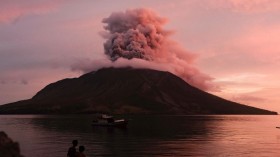To the Earth, the sun is one of the biggest, most stable constants in the universe as the heart of our solar system.
However, it wasn't always that way as new research confirms the sun's early years were wild and explosive. Scientists describe these tumultuous years akin to a toddler prone to tantrums during the infamous "terrible twos."
The Ancient Blue Crystals Almost As Old As The Sun
As Field Museum explains, the early years of the sun's life has long been a mystery. After all, the sun is 4.6 billion years old and predates the Earth by around 50 million years.
Thus, even with scientific advancements, it's nearly impossible to get ahold of an object in the planet that has an imprint of those early days billions of years ago. Even beyond Earth, hardly anything in the solar system has existed as long as the sun.
In the study published in the journal Nature Astronomy, researchers analyzed ancient blue crystals trapped in meteorites to paint a picture of the young, violent sun. These microscopic crystals containing calcium and aluminum are known as hibonite and are likely to be some of the very first particles ever formed in the solar system.
Prior to the formation of planets, the solar system simply consisted of the sun, which featured a disk of gas and dust spiraling around it. The disk's central region was extremely hot, reaching over 1500 degrees Celsius (2,700 degrees Fahrenheit), and as the disk cooled, the hibonite crystals begin to appear.
"These crystals formed over 4.5 billion years ago and preserve a record of some of the first events that took place in our Solar System," lead author Levke Kööp, a post-doc from the University of Chicago and affiliate of Field Museum, says in a statement. "And even though they are so small — many are less than 100 microns across — they were still able to retain these highly volatile nobles gases that were produced through irradiation from the young Sun such a long time ago."
Hibonite Crystals Tell The Story Of A Young Sun
In these early days when the crystals were first formed, the sun was still in its youthful, temperamental stage, constantly blasting out a barrage of protons and subatomic particles into space. Some of these hit the newly created hibonite crystals.
As the protons collided with the calcium and aluminum in the hibonite, the atoms ripped into smaller atoms of neon and helium, which remain trapped into the ancient blue crystals that made its way to Earth as part of meteorites that fell to the planet's surface.
The research team of the recent study analyzed the Murchison meteorite, which fell to Australia in 1969, according to New York Times.
It's these traces of neon and helium that offer the very first concrete evidence of the sun's explosive past of spewing particles into the young solar system.
© 2024 NatureWorldNews.com All rights reserved. Do not reproduce without permission.

![Extreme Heat Wave in Africa’s Sahel Region That Killed 100 People Linked to Climate Change [Study]](https://1471793142.rsc.cdn77.org/data/thumbs/full/70226/280/157/50/40/extreme-heat-wave-in-africa-s-sahel-region-that-killed-100-people-linked-to-climate-change-study.jpg)



